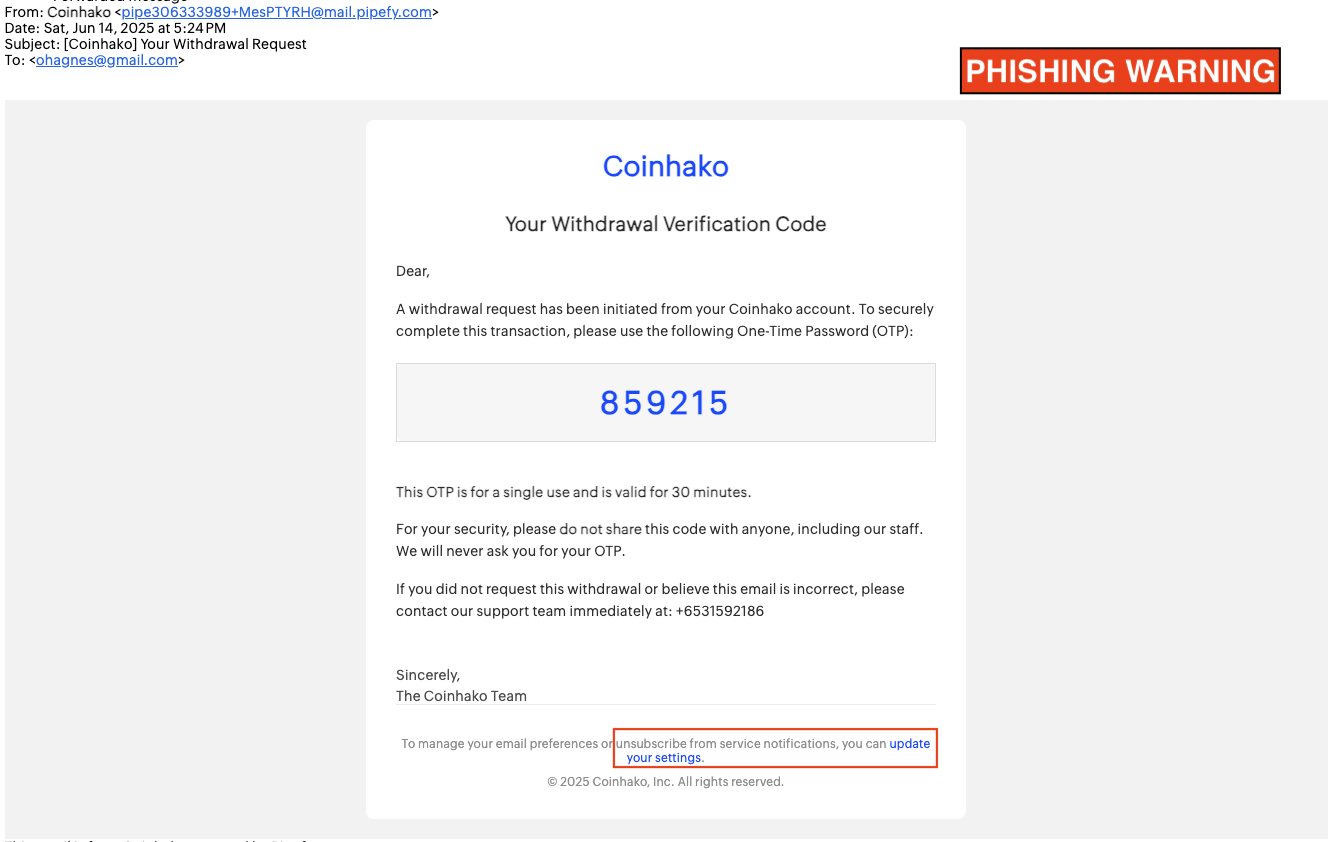How to Spot and Avoid Phishing Emails Pretending to Be from Coinhako
Phishing emails are designed to trick users into giving away sensitive information such as passwords, OTPs, or making contact through fake channels. These emails may look like they’re from Coinhako, but they’re actually from scammers. Below are key red flags to help you identify phishing attempts and protect your account.
Common Phishing Red Flags
1. Fake Email Addresses
Check if the sender’s email matches our official Coinhako addresses:
Official Coinhako email domains:
If the sender address doesn’t match the list above — do not trust it.
Examples of suspicious sender emails:
2. Requesting Sensitive Information
Legitimate companies — including Coinhako — will never ask for passwords, OTPs, or security codes via email, phone, or SMS.
Phishing emails may ask you to:
- Reply with your login credentials
- Share OTPs or 2FA codes
- Click links to input your password or seed phrase
3. Phone Numbers in Emails — Major Red Flag
- Coinhako does not provide customer support via phone.
- Legitimate Coinhako emails will never contain phone numbers for support.
- Any email that asks you to call a number — no matter how urgent it seems — is a phishing attempt.
Examples from phishing emails:
- +65 3159 0283
- +65 3159 2186
- +65 3159 2233

4. Suspicious Links
Scammers often hide malicious URLs behind text or buttons. Before clicking a link:
- Hover your mouse pointer over it (without clicking)
- Look at the bottom-left corner of your browser to see the actual URL
- Check if it leads to coinhako.com — if not, don’t click

5. Suspicious Login Location Alerts
Phishing emails often use fake login alerts to create panic.
Check if the details match your actual activity:
- Do you recognize the login location?
- Is the IP address familiar?
- Does the time zone match your current region?
If the login location shows something unusual (e.g. Havana, Cuba or Mumbai) and you didn’t log in — don't click anything in the email. Go directly to the Coinhako app or website to check.
6. Mismatched Branding
Look for subtle design flaws:
- Inconsistent logos or fonts
- Poor formatting
- Unusual language or grammar
If the email doesn't look exactly like official Coinhako emails you've seen before, don’t trust it.
7. Unexpected Attachments
Coinhako will never send files for you to open in email.
If an email includes a PDF, ZIP, DOC, or any file — treat it as suspicious.
If an email includes a PDF, ZIP, DOC, or any file — treat it as suspicious.
What an Official Coinhako Email Looks Like
A legitimate Coinhako security email will:
- Come from a verified Coinhako address
- Include accurate location/device/IP info
- Never ask you to call support
- Direct you to secure actions through official platforms only
Stay Safe: When in Doubt
- Never share OTPs or passwords with anyone
- Do not click on links or attachments you’re unsure about
- When in doubt, verify the information by going directly to www.coinhako.com or reaching out via our official Help Desk
- Bookmark this page for future reference and help spread awareness to keep our community safe from scams.
Related Articles
Not receiving Coinhako emails?
Why Am I Not Receiving Coinhako Emails? Not receiving our weekly email updates? Our emails may not be showing up in your inbox due to a variety of reasons. Stay in the loop! Simply run through our checklist of items below to ensure that you receive ...How to Use and Set up the Anti-Phishing Code on Coinhako
Phishing is a common scam where attackers pretend to be someone you trust—like Coinhako—in order to steal sensitive information or take control of your account. One simple and effective way to stay safe is by setting up your Anti-Phishing Code. What ...Coinhako's User Security Guide
At Coinhako, users' tokens and funds are our foremost priority. As we continue to ramp up security measures and maintain a secure platform for all users to trade, we would like to encourage users to play a part in their personal data protection as ...Tips to Avoid Telegram Scams
How Can I Avoid Scams On The Coinhako Telegram Group Chat? Telegram is a great communications platform for companies to engage with their communities and customers. We have made the decision to launch the official Coinhako Telegram Group to extend ...List of Official Coinhako Email Addresses
Recognize Official Coinhako Emails To protect yourself, please be aware that Coinhako will only send official communications from the following email addresses: hello@coinhako.com hello@updates.coinhako.com announcements@coinhako.com ...